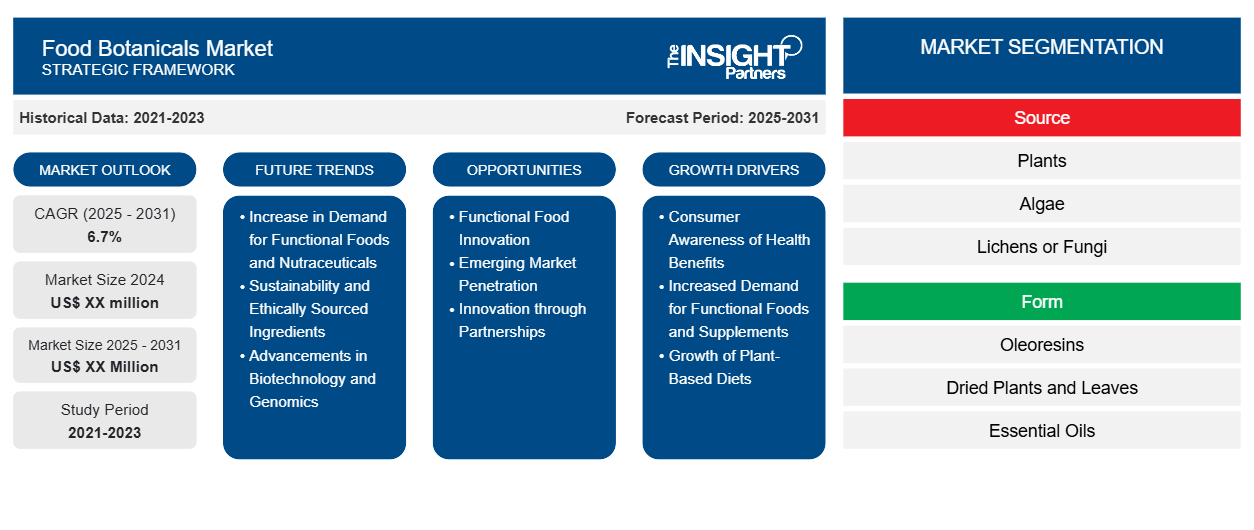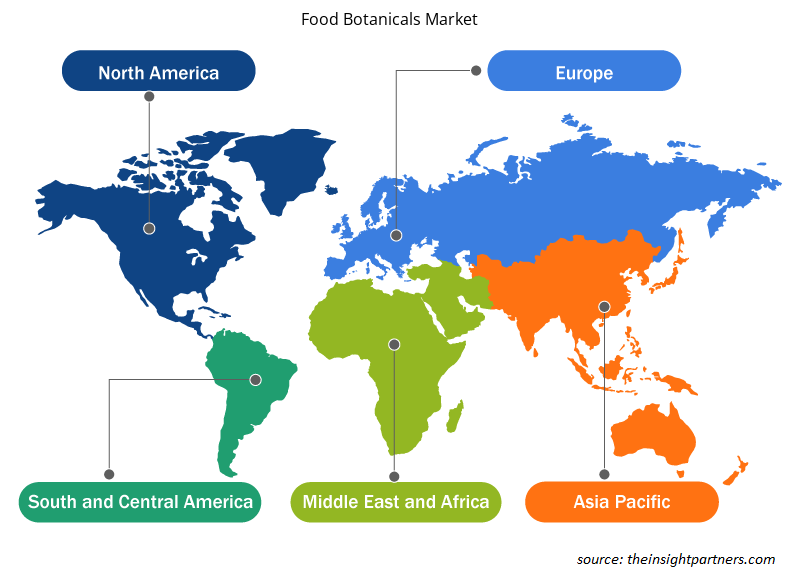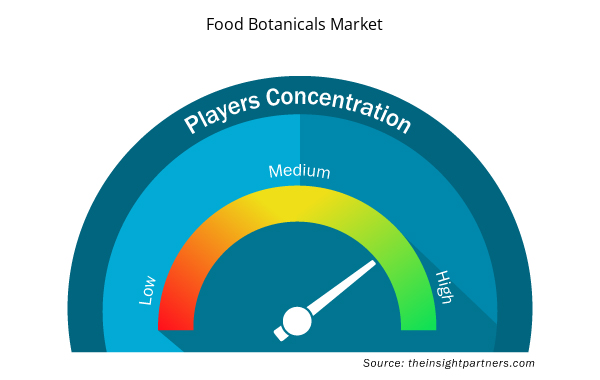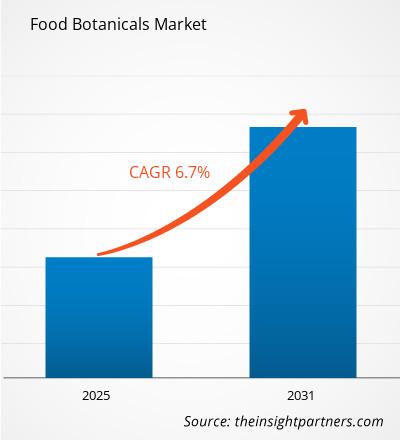The Food Botanicals Market is expected to register a CAGR of 6.7% from 2025 to 2031, with a market size expanding from US$ XX million in 2024 to US$ XX Million by 2031.
The Food Botanicals Market Report is segmented by source into Plants, Algae, Lichens, or Fungi. The form segment includes Oleoresins, Dried Plants and Leaves, and Essential Oils. The application segment includes Beverages, Supplements, Flavor Enhancers, and Confectionery. The end-user segment includes Household and Industrial. The market evaluation is presented in US$ for the above segmental analysis. The global analysis is broken down at the regional level and major countries. The market evaluation is presented in US$ for the above segmental analysis.
Purpose of the Report
The report Food Botanicals Market by The Insight Partners aims to describe the present landscape and future growth, top driving factors, challenges, and opportunities. This will provide insights to various business stakeholders, such as:
- Technology Providers/Manufacturers: To understand the evolving market dynamics and know the potential growth opportunities, enabling them to make informed strategic decisions.
- Investors: To conduct a comprehensive trend analysis regarding the market growth rate, market financial projections, and opportunities that exist across the value chain.
- Regulatory bodies: To regulate policies and police activities in the market with the aim of minimizing abuse, preserving investor trust and confidence, and upholding the integrity and stability of the market.
Food Botanicals Market Segmentation
Source
- Plants
- Algae
- Lichens or Fungi
Form
- Oleoresins
- Dried Plants and Leaves
- Essential Oils
Application
- Beverages
- Supplements
- Flavor Enhancers
- Confectionery
End-User
- Household
- Industrial
Customize This Report To Suit Your Requirement
You will get customization on any report - free of charge - including parts of this report, or country-level analysis, Excel Data pack, as well as avail great offers and discounts for start-ups & universities
Food Botanicals Market: Strategic Insights

- Get Top Key Market Trends of this report.This FREE sample will include data analysis, ranging from market trends to estimates and forecasts.
Food Botanicals Market Growth Drivers
- Consumer Awareness of Health Benefits: Rising consumer awareness about the health benefits of natural and organic products is a key growth driver for the Food Botanicals market. As consumers become more health-conscious, they increasingly seek food and beverages that contain botanical ingredients, which are seen as healthier and more natural alternatives to artificial additives and preservatives.
- Increased Demand for Functional Foods and Supplements: The growing prevalence of chronic diseases is fueling the demand for functional foods and supplements. Botanicals, known for their perceived health benefits, are becoming an integral part of products designed to support overall wellness and address specific health concerns.
- Growth of Plant-Based Diets: The rising popularity of plant-based diets, driven by increasing numbers of vegetarians and vegans, is further boosting demand for botanical-based food products and supplements. As more people adopt plant-based lifestyles, the need for supplements that align with these diets grows, contributing to the Food Botanicals market's expansion.
- Technological Advancements in Extraction and Processing: Advances in extraction and processing technologies are enhancing the functionality, taste, and texture of botanical-based products. These innovations are allowing companies to develop new and improved botanical products with better functional properties, making them more appealing to consumers.
Food Botanicals Market Future Trends
- Increase in Demand for Functional Foods and Nutraceuticals: The Food Botanicals market is experiencing significant growth driven by the rising demand for functional foods and nutraceuticals. Consumers are increasingly seeking botanical ingredients that provide specific benefits, such as anti-inflammatory properties, antioxidant effects, and enhanced mental acuity. This demand for health-oriented foods is leading to innovation in product design, where botanical ingredients are increasingly used in food and beverages.
- Sustainability and Ethically Sourced Ingredients: Consumers are becoming more sensitive to how their food is produced and are opting for products that use organic and fair-trade botanical ingredients. This shift is encouraging brands to focus on sourcing responsibly and sustainably, contributing to the growth of the market.
- Advancements in Biotechnology and Genomics: Technological advancements in biotechnology and genomics are enabling the discovery and development of novel botanical ingredients with improved properties. These innovations help enhance the functional benefits of botanicals, expanding their applications in food and beverages, and fostering further market growth.
Food Botanicals Market Opportunities
- Functional Food Innovation: New business opportunities in the food botanicals market are driven by the growing demand for functional food items made from botanical ingredients. Entrepreneurs can seize the chance to develop products that focus on specific health benefits, such as anti-inflammatory or antioxidant properties, derived from various botanical sources. This aligns with consumer preferences for healthier and more natural alternatives.
- Emerging Market Penetration: A significant opportunity lies in emerging markets, where the expanding middle class and their growing disposable income create demand for healthier products and Western dietary trends. Companies can cater to these markets by developing botanical-based food products tailored to local tastes and preferences, tapping into a new and promising customer base.
- Innovation through Partnerships: Collaboration between food manufacturers, botanical ingredient suppliers, and research institutions is key to driving innovation. By combining scientific research with indigenous knowledge, businesses can develop novel botanical-based products with enhanced health benefits, positioning themselves at the forefront of market trends.
Food Botanicals Market Regional Insights
The regional trends and factors influencing the Food Botanicals Market throughout the forecast period have been thoroughly explained by the analysts at Insight Partners. This section also discusses Food Botanicals Market segments and geography across North America, Europe, Asia Pacific, Middle East and Africa, and South and Central America.

- Get the Regional Specific Data for Food Botanicals Market
Food Botanicals Market Report Scope
| Report Attribute | Details |
|---|---|
| Market size in 2024 | US$ XX million |
| Market Size by 2031 | US$ XX Million |
| Global CAGR (2025 - 2031) | 6.7% |
| Historical Data | 2021-2023 |
| Forecast period | 2025-2031 |
| Segments Covered |
By Source
|
| Regions and Countries Covered | North America
|
| Market leaders and key company profiles |
Food Botanicals Market Players Density: Understanding Its Impact on Business Dynamics
The Food Botanicals Market market is growing rapidly, driven by increasing end-user demand due to factors such as evolving consumer preferences, technological advancements, and greater awareness of the product's benefits. As demand rises, businesses are expanding their offerings, innovating to meet consumer needs, and capitalizing on emerging trends, which further fuels market growth.
Market players density refers to the distribution of firms or companies operating within a particular market or industry. It indicates how many competitors (market players) are present in a given market space relative to its size or total market value.
Major Companies operating in the Food Botanicals Market are:
- Arcadian Organic and Natural Meat Co. Pty Ltd.
- Associated British Foods plc
- Bayer AG
- Bio Botanica, Inc.
- International Flavors and Fragrances Inc.
Disclaimer: The companies listed above are not ranked in any particular order.

- Get the Food Botanicals Market top key players overview
Key Selling Points
- Comprehensive Coverage: The report comprehensively covers the analysis of products, services, types, and end users of the Food Botanicals Market, providing a holistic landscape.
- Expert Analysis: The report is compiled based on the in-depth understanding of industry experts and analysts.
- Up-to-date Information: The report assures business relevance due to its coverage of recent information and data trends.
- Customization Options: This report can be customized to cater to specific client requirements and suit the business strategies aptly.
The research report on the Food Botanicals Market can, therefore, help spearhead the trail of decoding and understanding the industry scenario and growth prospects. Although there can be a few valid concerns, the overall benefits of this report tend to outweigh the disadvantages.
- Historical Analysis (2 Years), Base Year, Forecast (7 Years) with CAGR
- PEST and SWOT Analysis
- Market Size Value / Volume - Global, Regional, Country
- Industry and Competitive Landscape
- Excel Dataset



Report Coverage
Revenue forecast, Company Analysis, Industry landscape, Growth factors, and Trends

Segment Covered
This text is related
to segments covered.

Regional Scope
North America, Europe, Asia Pacific, Middle East & Africa, South & Central America

Country Scope
This text is related
to country scope.
Frequently Asked Questions
The leading players of the market are: Arcadian Organic & Natural Meat Co. Pty Ltd., Associated British Foods plc, Bayer AG, Bio Botanica, Inc., International Flavors & Fragrances Inc., Kerry Group plc, Lipoid Kosmetik AG, Marfrig Global Foods, The Himalaya Drug company, Tyson Foods, Inc.
The report can be delivered in PDF/PPT format; we can also share excel dataset based on the request.
Some of the customization options available based on request are additional 3–5 company profiles and country-specific analysis of 3–5 countries of your choice. Customizations are to be requested/discussed before making final order confirmation, as our team would review the same and check the feasibility.
The Food Botanicals Market is expected to grow significantly due to the following emerging trends:. Functional foods and nutraceuticals will become a main trend because of the focus on health benefits that botanical ingredients provide, thereby driving product innovation. A rising trend will be demand for sustainable and ethically sourced botanical ingredients, since consumers are beginning to make decisions based on environmental and social responsibility. Biotechnology and genomics will help to develop new botanical ingredients with enhanced properties, driving further market growth.
Food Botanicals Market is expected to grow at a CAGR of 6.7% between 2023-2031
There are a number of driving factors in the Food Botanicals Market. Key factors driving this market include growing consumer awareness about the health benefits that accompany natural and organic products. Consumers have started seeking products free from artificial additives, leading to a hike in demand for botanical ingredients. The increasing incidence of chronic diseases is driving the demand for functional foods and dietary supplements that contain botanical ingredients with potential health benefits. Moreover, technological advancements in extraction and processing are making it possible to develop novel botanical-based products with improved functional properties and taste and texture.
Trends and growth analysis reports related to Food and Beverages : READ MORE..
1. Arcadian Organic and Natural Meat Co. Pty Ltd.
2. Associated British Foods plc
3. Bayer AG
4. Bio Botanica, Inc.
5. International Flavors and Fragrances Inc.
6. Kerry Group plc
7. Lipoid Kosmetik AG
8. Marfrig Global Foods
9. The Himalaya Drug company
10. Tyson Foods, Inc.

 Get Free Sample For
Get Free Sample For